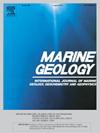Morphologically adaptive modelling of sea level rise induced coastal erosion impacts for south-east Australia
IF 2.2
3区 地球科学
Q2 GEOSCIENCES, MULTIDISCIPLINARY
引用次数: 0
Abstract
Sea level rise induced coastal erosion represents an impending threat to the world's coastlines. A critical control on coastal recession is the onshore accommodation space available for a receding beach to occupy. Despite the importance of morphologic controls, coastal change models applied at regional-scale over ∼100-year time-frames typically address a limited range of coastal morphologies.
ShoreTrans is a shoreface translation model that kinematically projects profile change, based on inputs of sea level rise and sediment budget imbalances. This work presents updates to enable broad-scale model application (1000's km), automating classification and adapting to the morphology of individual profiles, including: (1) dunes; (2) cliffs; (3) bluffs and ridges; (4) inter-subtidal rock outcrops; (5) protection structures; (6) low-energy environments; and (7) short-term dune erosion. The model was applied to Victoria, Australia (2000 km coastline, 30 m spaced transects), for a scenario of 1 m sea level rise from 2010 to 2100, using a single time step and simplified treatment of uncertainty and sediment budget. Shoreline trends and variability were determined from satellite extracted shorelines.
Mean projected shoreline recession of 43 m is 20 % lower than for a simple parameterization (uncertainty range 58 % lower to 8 % higher), due to sediment transfer from the backshore to the active shoreface (e.g., dune encroachment) and hard backshores restricting shoreline movements (e.g., cliffs, seawalls). Low dunes exhibited the highest recession rates, due to rollover (68 m long-term recession). Total setback extent, including short-term variability, is projected to exceed 182 m in 5 % of low dune areas. High rates of beach loss were associated with beaches fronting hard cliffs (55 % beach loss) and seawalls (80 %). The worst impacts are expected for rocky, sediment poor coastlines, such as the Great Ocean Road Surf Coast, where a loss of 30 % to 50 % of beaches is projected, not accounting for infrastructure and potential management interventions.
Automated morphological adaptation represents a step-change for regional scale coastal change assessment. The method also allows for coupling of future erosion to inundation hazards, by interpolating a 3D surface of future morphology. At local-scale, ShoreTrans is suitable to add to hybrid models, providing a means to improve future coastal change projections.
澳大利亚东南部海平面上升引起的海岸侵蚀影响的形态适应性模拟
海平面上升引起的海岸侵蚀对世界海岸线构成了迫在眉睫的威胁。对海岸衰退的一个关键控制是岸上可供后退的海滩占用的容纳空间。尽管形态控制很重要,但在区域尺度上应用的沿海变化模型通常只能处理有限范围的沿海形态。ShoreTrans是一个基于海平面上升和泥沙收支不平衡输入的岸面平移模型,它可以动态地预测剖面变化。这项工作提出了更新,以实现大尺度模型应用(1000公里),自动分类和适应单个剖面的形态,包括:(1)沙丘;(2)悬崖;(三)崖、脊;(4)潮下岩露头;(五)防护结构;(6)低能环境;(7)短期沙丘侵蚀。该模型应用于澳大利亚维多利亚州(2000公里海岸线,30米间隔的样带),用于2010年至2100年海平面上升1米的情景,使用单一时间步长并简化了不确定性和沉积物预算的处理。海岸线趋势和变率由卫星提取的海岸线确定。由于泥沙从后海岸转移到活动的海岸面(如沙丘侵蚀)和坚硬的后海岸限制海岸线移动(如悬崖、海堤),平均预估的海岸线后退43米比简单的参数化低20%(不确定性范围低58%至高8%)。低沙丘表现出最高的衰退率,由于滚动(68 m长期衰退)。在5%的低沙丘区,包括短期变率在内的总退缩范围预计将超过182米。海滩损失的高比率与面对硬悬崖(55%的海滩损失)和海堤(80%)的海滩有关。最严重的影响预计是在岩石和沉积物较少的海岸线,如大洋路冲浪海岸,预计将损失30%至50%的海滩,这还不包括基础设施和潜在的管理干预措施。自动形态适应是区域尺度海岸带变化评估的一种阶段性变化。该方法还允许通过插值未来形态的3D表面来耦合未来的侵蚀和淹没危害。在局部尺度上,ShoreTrans适合添加到混合模型中,为改善未来海岸变化预测提供了一种手段。
本文章由计算机程序翻译,如有差异,请以英文原文为准。
求助全文
约1分钟内获得全文
求助全文
来源期刊

Marine Geology
地学-地球科学综合
CiteScore
6.10
自引率
6.90%
发文量
175
审稿时长
21.9 weeks
期刊介绍:
Marine Geology is the premier international journal on marine geological processes in the broadest sense. We seek papers that are comprehensive, interdisciplinary and synthetic that will be lasting contributions to the field. Although most papers are based on regional studies, they must demonstrate new findings of international significance. We accept papers on subjects as diverse as seafloor hydrothermal systems, beach dynamics, early diagenesis, microbiological studies in sediments, palaeoclimate studies and geophysical studies of the seabed. We encourage papers that address emerging new fields, for example the influence of anthropogenic processes on coastal/marine geology and coastal/marine geoarchaeology. We insist that the papers are concerned with the marine realm and that they deal with geology: with rocks, sediments, and physical and chemical processes affecting them. Papers should address scientific hypotheses: highly descriptive data compilations or papers that deal only with marine management and risk assessment should be submitted to other journals. Papers on laboratory or modelling studies must demonstrate direct relevance to marine processes or deposits. The primary criteria for acceptance of papers is that the science is of high quality, novel, significant, and of broad international interest.
 求助内容:
求助内容: 应助结果提醒方式:
应助结果提醒方式:


